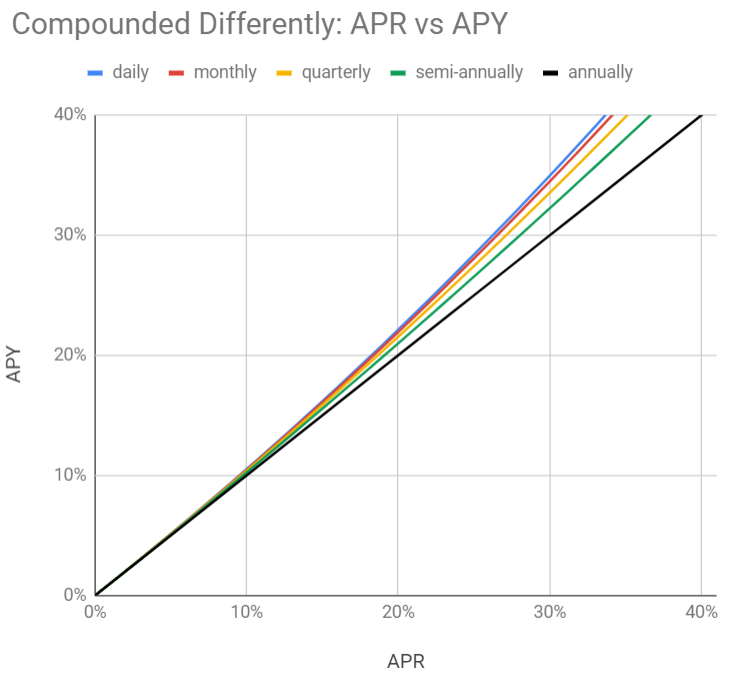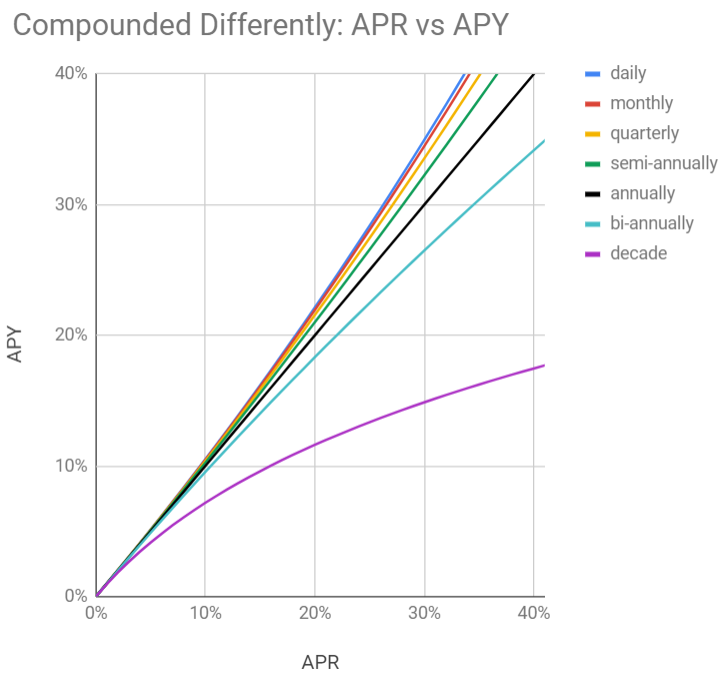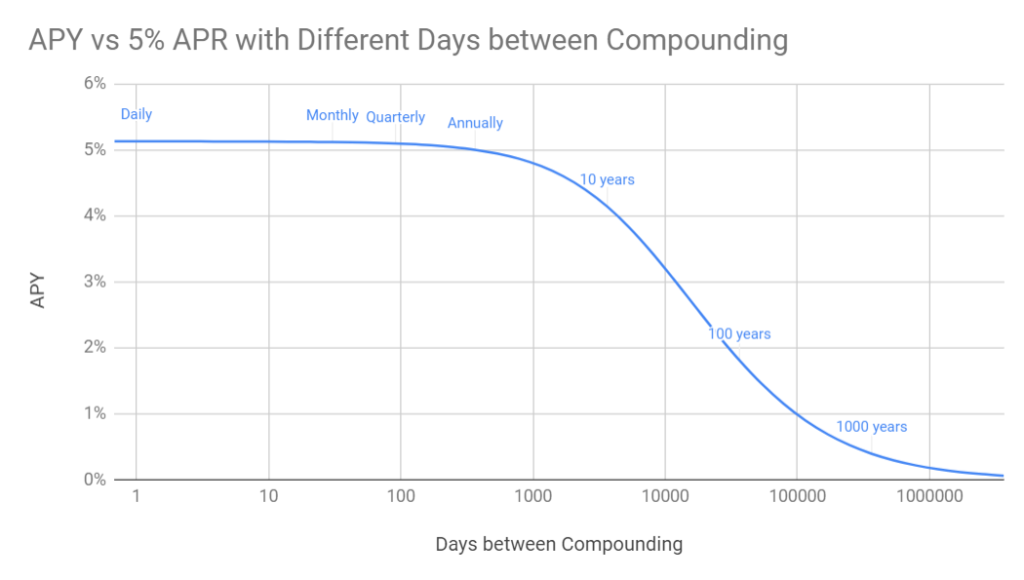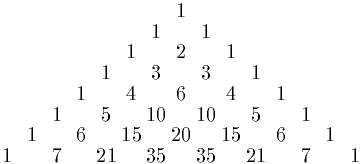Savings accounts, loans, and various financial products will often express interest rate as APR or APY. They are very similar but describe subtly different things.
APR
APR stands for Annual Percentage Rate. This is the interest rate that is applied directly to the money. How often the interest is calculated, daily, weekly, monthly, or whatever period of time, doesn’t change the APR.
The calculated interest for a set period of time would be:
\(interest \space rate \space for \space set \space period \space of \space time = \frac{APR}{frequency \space per \space year}\)
For example, if the interest is calculated monthly, then the monthly interest rate would just be:
\(monthly \space interest \space rate = \frac{APR} {12}\)
APY
APY stands for Annual Percentage Yield. This is the equivalent interest rate if calculated yearly. This is best shown using a comparison with APR.
APR vs APY Comparison
For example, if you have a given APR for a savings account that you do not withdraw from, with the interest calculated monthly, then your balance after each month would be as such.
1 month
\(Initial \space Balance * (1+\frac{APR}{12})\)
2 months
\(Initial \space Balance * (1+\frac{APR}{12})^{2}\)
.
.
.
12 months
\(Initial \space Balance * (1+\frac{APR}{12})^{12}\)
Your APY is \((1+\frac{APR}{12})^{12}-1\)
If your \(monthly \space APR = 5\%\), then your
\(APY = (1+\frac{5\%}{12})^{12}-1=5.116\%\)
APY is assuming you let the balance and any interest sit. This allows the interest to also grow! Interest from interest!
Here is a chart showing what happens if you compound your APR differently.

For 5% APR, you can get almost up to 5.13% APY! If you have a savings account, they will most likely advertise the higher 5.13% APY instead of 5% APR. If you have a credit card, they would advertise the APR since it would make their loan interest look lower!

Extra Interesting Thoughts
What I find interesting is that there is a limit to how high your APY can go with a given APR. However, also something I don’t see often is the opposite direction! For example, if someone says they’ll give you 50% interest total after 10 years. That is a 5% APR, but the APY will be LOWER since it is compounded by the decade!


APY as compounding frequency vanishes!
Even more interesting is that there is a limit for how HIGH APY can go, but there is none for how LOW APY can go (though it can’t go negative). You might be wondering how that would look on a graph. I thought that too!

For 5% APR, you can see that APY has a minimum of 0% if you wait longggggg enough! The other spectrum is just as intriguing since even if you compound it every day, or every hour, or second, or millisecond, it won’t go above 5.13%!
Mathematically, we have
\(APY = (1+\frac{APR}{Frequency})^{Frequency} -1\)With compounding frequency of less than once per year, frequency goes below 1, and can approach 0. Therefore, minimum APY would be
\(Lim_{Frequency\to 0}APY=(1+ \frac{APR}{Frequency} )^{Frequency}-1=1-1=0\)
It is not particularly intiuitive to me why the first term goes to 0. The exponent goes to 0, but the base goes to infinity!
APY as compounding frequency increases
On the other hand, as compounding frequency increases we hit a different limit.
\(APY \space Semi-Annually = (1+2*\frac{APR}{Frequency} +1*\frac{APR}{Frequency} )^2-1\\
APY \space 3x/year = (1+3*\frac{APR}{Frequency} +3\frac{APR}{Frequency} ^2 + 1*\frac{APR}{Frequency} )^3-1\)
As you can see, there is a pattern as the compounding frequency changes. Namely, binomial expansion.

The coefficients follow this pattern, also called Pascal’s Triangle.
The notation for the coefficients can be written as such:

\\
+{Frequency \choose 1}\frac{APR}{Frequency} ^2
\\
+{Frequency \choose 2} \frac{APR}{Frequency}^3\\
+{Frequency \choose 3} \frac{APR}{Frequency}^4\\
+{Frequency\choose Frequency}\frac{APR}{Frequency}^{Frequency}\\
+…….)-1 \\
APY= (\Sigma_{n=0}^{n=Frequency}\frac{APR}{Frequency}^n*\frac{Frequency!}{n!*(Frequency-n)!})-1
\)
This probably isn’t the correct way to solve it. The best way is probably to go back to
\(APY = (1+\frac{APR}{Frequency})^{Frequency} -1\) and take the limit as Frequency goes to infinity.

Again, not intuitive for me at all. I would browse the web for derivations and information to try to understand it better. https://socratic.org/questions/what-is-the-limit-of-1-1-x-x-as-x-approaches-infinity-2
Thinking out loud, if I go from compounding annually, to monthly, to daily, to hourly, each step is more than a 10x decrease. However, the gain in APY is minimal. On the other hand, going from annually, to a decade, or 100 years, is also 10x difference. But this DRASTICALLY decreases the APY. The takeaway is that APR and APY are quite similar if calculated within a year or short time span. However, compounding year after year with a longer time horizon, even small differences can make a very big difference no matter what so be weary!
Understanding these mathematical equations is is quite a challenge.. and I feel my littler brain frying already!
APY vs APR
Comment below! Do you better understand APY and APR after this article? What do you think about the different uses of APY and APR by various entities?
